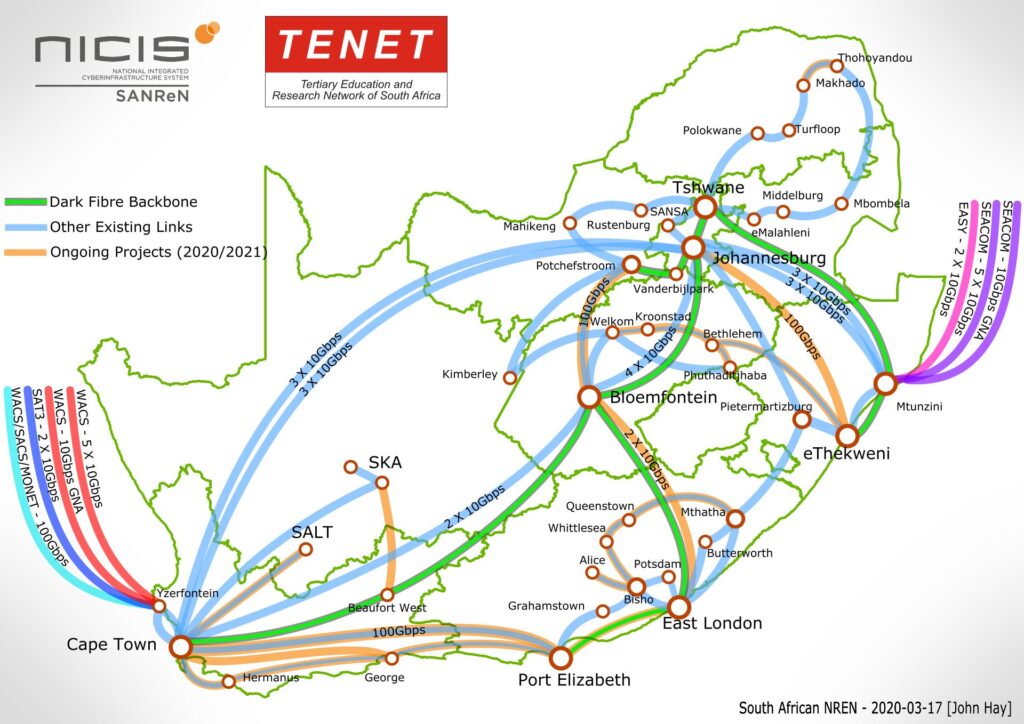The South African National Research Network (SANReN) is building out a fibre network that is capable of speeds in excess of 9,600 gigabits per second (Gbps).
This massive network serves South Africa’s academic and scientific community and will be an essential component of the Square Kilometre Array (SKA) when it is fully built in the latter half of the decade.
SANReN’s group lead for network engineering, Siju Mammen, told MyBroadband that the MeerKAT radio telescope currently requires peak speeds of 20Gbps. These bandwidth demands will only increase in the coming years.
MeerKAT will continue to expand as part of the first phase of the SKA project, and will eventually require as much as 10 terabits per second (Tbps) of bandwidth. That is five hundred times the bandwidth it currently uses, or 10,000Gbps.
Since the SKA will be comprised of teams around the world and will have sensors in South Africa and Australia, the data from MeerKAT will have to be sent over international links so that researchers across the globe can collaborate on the project.
Mammen explained that to optimise the amount of international bandwidth required by MeerKAT, the data it captures will first be processed by a correlator. This will reduce the bandwidth requirements of the SKA’s international link down to 100Gbps.
“When the second phase of the SKA comes online it will generate an order of magnitude more data than SKA1,” Mammen said.
SANReN, therefore, has to design its network knowing that in ten years, it will have to handle at least ten-times the amount of traffic from the SKA. Its international bandwidth needs are also expected to increase tenfold, up to 1Tbps.
Building a terabit per second network
To get the bandwidth it needs to support South African academic and scientific institutions, SANReN has commissioned several high-capacity national and regional fibre links in South Africa.
It currently has a total pool of 890Gbps of capacity that it can aggregate on its network around South Africa.
For its international capacity needs, SANReN has made deals with various undersea cable providers.
The director of SANReN, Leon Staphorst explained to MyBroadband that in 2011, the Tertiary Education and Research Network of South Africa (TENET) bought 10Gbps of capacity on SEACOM through a complex financing deal with the Industrial Development Corporation.
State-owned entity Broadband Infraco bought capacity in the West African Cable System (WACS) in 2013 and currently owns 11.4% of the capacity on the cable. Of that, 65% is owned by SANReN.
SANReN has also participated in the 2014 and 2018 upgrades of WACS, allowing it to increase the amount of capacity it owns on the cable.
In total, SANReN has 260Gbps of international capacity, but almost all of this is concentrated in WACS.
To diversify the international routes connecting SANReN to the rest of the world, Staphorst said they did several swap deals through TENET. They have swapped some of their capacity on WACS for 50Gbps on SEACOM, 20Gbps on SAT-3, and 20Gbps on EASSy.
“We now have four subsea cables connecting the national research network,” Staphorst said.
In addition to the like-for-like international capacity swaps, SANReN has also swapped WACS bandwidth for 10Gbps of overland national backhaul capacity.
The journey to 10Tbps
Staphorst said that for the last few years, SANReN’s focus has been the upgrade of its core and national backbone to cope with the demands of South Africa’s research community, especially the SKA.
A major part of its network upgrade has been the rollout of dense wavelength division multiplexing (DWDM) technology which can provide 100Gbps of bandwidth for each wavelength of light, or channel, that the fibre cable carries.
SANReN’s network currently supports 96 channels per fibre cable, giving it a design capacity of 9.6Tbps in its backbone.
In addition to deploying DWDM, SANReN has also done a significant amount of work to extend its backbone to rural areas and upgrade the capacity in outlying areas to 10Gbps.
It is currently in the procurement stages of building the missing piece of its network between Beaufort West and Carnarvon to connect the SKA with its backbone.
Because of how remote the SKA is, the build between Carnarvon and Beaufort West is challenging. Staphorst explained that some of the fibre will be run in trenches that must be dug along a gravel road, while some of the cables will need to be hung overhead on poles.
Once the build between Beaufort West and Carnarvon is completed, this will give SANReN a redundant cable route from the Square Kilometre Array into its core network.



